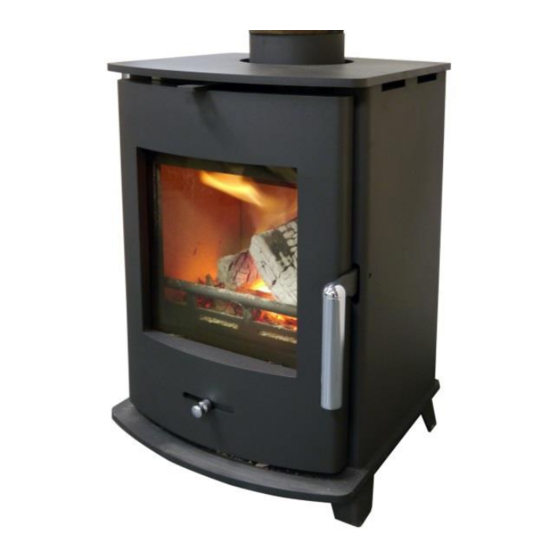Advertisement
NEWBOURNE 35/40/50/60FS & PANORAMA RANGE
WOOD AND MULTI FUEL FREE STANDING STOVES
CE and EN13240 Approved
APPROVED FOR USE IN SMOKE CONTROL AREAS WHEN
BURNING DRY WOOD LOGS OR AUTHORISED FUELS
Manufactured and Distributed by Pevex Enterprises Ltd
Unit MP7 Kirrawah Business Park, Waldringfield, Ipswich, IP12 4PR.
Tel: 01473 736399
Fax: 01473 736406
Congratulations on the purchase of your new Newbourne stove. Your new purchase will provide you with a
level of pleasure and comfort not previously experienced in your home.
The Newbourne is a heavy duty British designed multifuel stove. It has been designed for easy installation and
ease of use giving a lovely flame pattern when burning wood and a wonderful warm radiant and convection
heat. The stoves are highly efficient with a clean burn firebox and efficiencies above 80% (Net) when burning
wood and features a curved door, large glass window, vermiculite insulated firebox, convector top plate, bolt
on adjustable feet, ergonomic handle and heavy weight steel construction.
Please read and follow the advice and instructions on the safe and efficient operation of your stove to
ensure it has a long trouble free life and also read and follow the installation instructions before
installing the stove.
PART 1 OPERATING INSTRUCTIONS
A stove compared with an open fire is a very efficient heating appliance and must be installed and used safely
and wisely, it is important to understand the working of such an appliance and to understand the process of
converting the fuel into heat and its efficient transfer from the firebox to the room in order to gain the most from
the stove.
A stove creates an almost perfect environment to burn wood in. The firebox will run at a very high temperature
ideal to burn the volatiles given off in the burning process and the precise air controls allow minimal heat loss
into the flue. Newbourne stoveS operates at an efficiency of 73 % and 76% on a Gross CV basis (78-83%
Net) and is very much more efficient than an open fire avoiding the wasteful draughts normally associated with
that type of appliance
Burning wood is the natural way to store the sun's energy to then be released in a carbon neutral process to
heat your house when the need is most. On a cold winters night there is nothing to beat the release of heat
and flame in a stove to raise the spirit.
The preparation and burning of wood as a fuel in stoves can be traced back many centuries, however it is a
forgotten or maybe never fully discovered activity in the United Kingdom, we have much to learn from our
1
Installation and Operating Instructions for Newbourne 35/40/50/60FS Multi Fuel Stoves
Ref: Pevex1022/AH/ver1:May2015
Advertisement
Table of Contents

Summarization of Contents
Newbourne Stove Introduction
Approved for Smoke Control Areas
Information on approved fuels for use in smoke control areas.
Key Stove Features
Highlights the stove's design for efficient heating and user comfort.
Part 1: Operating Instructions
Stove Operation Principles and Efficiency
Explains efficient heat conversion and benefits over open fires.
Safety Warnings: Fume Emission and Blockages
Crucial safety advice on fume emission risks and chimney blockages.
Chimney Cleaning and Maintenance
Guidelines for regular chimney sweeping and cleaning flue components.
First Firing and Fuel Recommendations
Instructions for initial firing and lists recommended fuels.
Fuel Types and Consumption
Details on fuel quality, usage in smoke control areas, and consumption rates.
Lighting and Combustion Control
How to use air sliders and manage combustion for optimal heat output.
Step-by-Step Stove Lighting
Visual guide detailing the process of lighting the stove correctly.
Safe Operation and Fire Control
Key safety advice on firebox loading, air sliders, and blowback prevention.
Stove Maintenance and Cleaning
Instructions for cleaning the stove's exterior paint and interior glass.
Operational Problem Solving
Addresses common issues like smoke, draught problems, and solutions.
Seasonal Stand Down Procedures
Procedures for preparing the stove for storage at the end of the burning season.
Part II: Installation Instructions
Installer Requirements and Regulations
Emphasizes HETAS registration and compliance with Building Regulations.
CO Alarm Mandate
Requirement for installing carbon monoxide alarms in the appliance room.
Installation Health and Safety
Precautions for handling materials, fire cement, and potential asbestos.
Assessing Installation Requirements
Guidance on selecting stove size and assessing chimney/hearth needs.
Hearth and Clearance Guidelines
Minimum hearth dimensions and clearance distances from combustible materials.
Baffle Plate Removal Guide
Detailed steps to remove baffles for accessing the flue system for cleaning.
Chimney and Fluepipe Safety
Critical warnings and guidelines for chimney height, draught, bends, and connection.
Ventilation Requirements
Specifies ventilation needs based on house build date and air leakage rates.
Commissioning and First Firing
Essential checks and first firing procedures post-installation.
Appendices
Appendix A: Clean Air Act Overview
Explains the Clean Air Act, smoke control areas, and exempt appliances.
Appendix B: Technical Specifications
Provides detailed technical data, dimensions, and performance metrics.







Need help?
Do you have a question about the NEWBOURNE 40FS and is the answer not in the manual?
Questions and answers